Jun 2015
Abandoned newborn seal pup rescued from Lincoln Park
Jun/28/15 12:49 PM
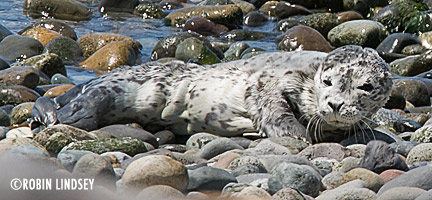
The pup was first sighted on the beach by Colman Pool early Thursday morning, but was not immediately reported to Seal Sitters. When we received a report hours later, First Responder Lynn arrived at the Park and saw four off-leash dogs on the beach. According to the woman who called the hotline, the pup was scared into the water by approaching people. The pup was swimming around in the water, desperately trying to crawl up onto a cement pillar just offshore. Thankfully, he returned to the beach shortly thereafter and Lynn established a large tape perimeter. She knew that any pup on the beach in South Puget Sound in late June/early July is a newborn and would still be nursing.
Under an unrelentingly hot sun, the very tiny pup was watched over by volunteers in shifts. Due to close proximity to the sidewalk and public pool, visitors to the park were asked to take a short detour around the pool building. This was all in hopes that mom might return to feed the thin pup. Except for a few peeved people, everyone was extremely cooperative, especially when they realized the urgent situation for the pup. However, with a park full of activity, including people along the water’s edge north and south of the perimeter, and the excited voices of children swimming in the nearby public pool, the scenario of mom’s return was extremely dubious. The pup entered the water several times during the day, probably taking a dip to cool down, sometimes calling plaintively to be fed. At 10pm when darkness fell, there was still no sign of mom swimming anywhere nearby.
On Friday morning, the pup was discovered onshore just south of the point where the pool is located. First Responders David and Eilene set a generous perimeter and volunteers were lined up for yet another terribly hot and busy day at the Park. The pup, nicknamed Little Dipper, was markedly thinner and much less alert than the previous day. Health assessment photos taken with a long telephoto definitively showed the the pup’s jutting hip and shoulder bones. It was now clear that the pup was emaciated and not being fed.
Not every struggling seal pup is a candidate for the very few spaces available at our Northwest rehabilitation facilities. Each pup is evaluated on a case by case basis for candidacy since the harbor seal population is considered to be at healthy levels and there is a 50% mortality in the wild for pups in their first year. It is NOAA’s policy that spaces are generally reserved for cases of human interaction, including pups with serious injuries. A seal pup that ends up in rehab will usually be at a facility for two or more months.Read here about NOAA’s rehabilitation policy for full-term pups.
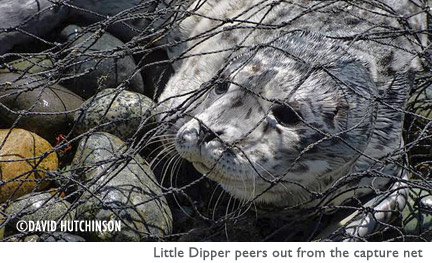
Since the pup was just feet from the incoming tide, a salmon landing net on the end of a pole was gently placed over the pup to prevent his escape. Much to our surprise (and not shown in photos), Little Dipper had a fleshy umbilical cord dangling from his sunken belly and estimated to be 3-5 days old.
Interestingly, on Wednesday evening Seal Sitters’ hotline received a report that a pup with umbilicus attached had followed a man in his watercraft off Emma Schmitz Park. We are assuming this was Little Dipper.
On arrival at PAWS, the male pup weighed a mere 8.4 kg and veterinarians confirmed the pup was emaciated and had not eaten in days. Little Dipper had two puncture/bite wounds about 1/2” deep on the head and a laceration near the tail. The wounds do not appear to be serious and are being treated with antibiotics.
On Saturday, PAWS staff reported that Little Dipper was much more vibrant after being hydrated and stabilized. The prognosis is now good for his survival, assuming there are no underlying health issues.
Thanks to all of the many volunteers - including a number of our brand-new volunteers from the June training - who helped out over the two days Little Dipper was on shore. Dealing with large crowds of people can be a challenge and everyone performed fantastically. Seal Sitters would also like to give special thanks to Seattle Parks’ staff Carol, Charles, Dino and Kyle who provided assistance on Friday. We so value our great relationship with the Southwest Division.
Stay posted for health updates on Little Dipper from the dedicated rehab folks at PAWS!
PUPDATE (7/3/15)
Little Dipper is doing pretty well according to PAWS Wildlife Center rehabilitation manager Emily Meredith. The pup’s wounds, including the two punctures on the head from an undetermined animal, are healing thanks to antibiotics. Little Dipper is being tube-fed “seal formula.” While formula is never as good as a mom’s milk with her natural antibodies, he has gained almost a full kilogram in weight under PAWS’ care. Little Dipper has been enjoying his big outdoor pool.
See recent photos and read about Little Dipper’s treatment at PAWS on their blog here. We can’t thank PAWS dedicated staff enough for giving this pup a second chance.
Burien fin whale skeleton gets new life for public display
Jun/28/15 06:50 AM
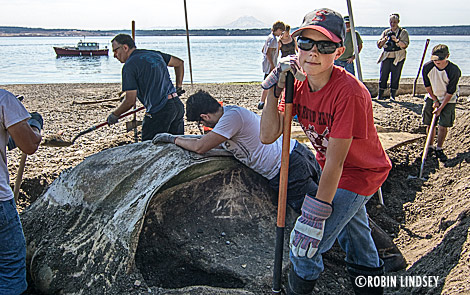
The endangered whale was killed by a ship strike, likely brought into Puget Sound on the bow of a large ship, and floated ashore at Burien’s Seahurst Park in April of 2013. Seal Sitters volunteers assisted in crowd control as hordes of people flocked to the park to view the second largest species of whale - and animal - in the world. Following a limited necropsy by Cascadia Research Collective and Washington Department of Fish and Wildlife/Marine Mammal Investigations Unit, the carcass was towed to a South Puget Sound island for further examination and left to naturally decompose on the remote beach.
Next began the search to find an institution interested in the bones for an educational display. Foss Waterway Seaport, located on Tacoma’s waterfront, jumped at the opportunity to feature the huge skull and other bones at their museum. Although the skeleton was incomplete because the whale was literally cut in half by the ship, Seaport Director of Education, Jan Adams, believed the skull would prove a wonderful learning experience.
Brainstorming with her 14-year old son Gregg about possible Eagle Scout service projects, WDFW’s marine mammal biologist Dyanna Lambourn asked if he might want to lead his troop in unearthing the whale. Gregg presented the idea to his fellow Scouts who enthusiastically agreed to help with the unique endeavor. After substantial planning, the complex service project was approved by leadership in the Chief Seattle Council. In 2013 alone, members of the Boy Scouts of America, working toward achieving the rank of Eagle Scout, donated 9.3 million service hours on projects that benefited communities across the country.
On Friday night, 6 Scout team leaders (along with the Scoutmaster and adult leaders) camped out in the woods of the island, preparing for the big dig. In the early morning light, the remaining 5 Scouts from the troop (ages 11-14) were shuttled across the water from Fox Island by WDFW in a pair of sturdy Boston Whaler research boats. A handful of volunteers from Highline College’s Marine and Science Technology (MaST) later arrived with Foss Waterway staff on a refurbished U.S. Coast Guard research vessel which chugged all the way from Tacoma. Eggs were scrambled for breakfast burritos and coolers full of water, Gatorade and food for the day were lined up for the crew.
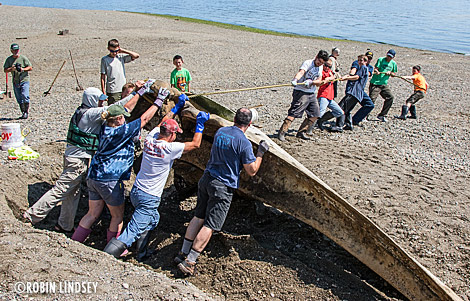
The team tugged and pushed the estimated 1,000 lb skull and its lower two jaws, each weighing more than 500 lbs, to the water’s edge. A barge from Nisqually Marine Services, requiring only an 18” depth of water and equipped with a crane, raised the mammoth bones up onto the deck for transport to the museum where they will be scrubbed clean, dried and prepped for exhibition.
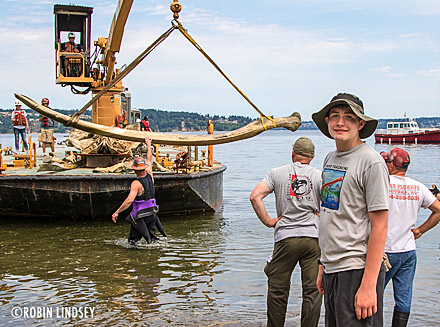
Once on display at Foss Seaport Waterway’s museum (hopefully by late July), the bone artifacts will educate scores of visitors about majestic fin whales - and the increasing dangers of ship strikes to the many species of whales who migrate along our Pacific Coast.
Pupping season gets off to an early - and rough - start
Jun/14/15 04:29 PM
For the second June in a row, Seal Sitters has responded to a premature pup on West Seattle’s shore. At 5pm on Wednesday, the hotline fielded a call about a tiny pup resting near the Alki Lighthouse on Coast Guard property.
First Responder Lynn was on the scene within minutes. Through her binoculars, she could see that the pup was covered almost entirely in fluffy, white lanugo fur, normally shed inside the womb as a pup matures to full-term before birth. A fleshy umbilicus was visible. Lynn’s heart sank. She knew it was going to be a tremendous challenge to keep the beach quiet in hopes mom might return to nurse him.
It was urgent to keep the public - and dogs - as far away as possible and volunteers out of sight as well. Lynn immediately called the volunteer scheduler for the day. Denise checked the online calendar and began ringing volunteers who had entered time for the day. Wearing blue i.d. vests, they were stationed alongside barricades strung with yellow tape, far down the beach south and north of the lighthouse. Waterfront homeowners were alerted that a newborn pup was on the beach and asked to please keep a low profile - they were happy do anything to help. It was truly a life and death situation for the pup.
Neighbors graciously allowed First Responders Lynn and David access through their property so we could periodically get quick health assessment photos, crouched on their deck (Seal Sitters owes them tremendous thanks). Photos revealed that the pup was 80% lanugo (about 2 weeks premature) and, based on the condition of the umbilicus, was possibly a few days old. The pup was nicknamed Wynken, from the beloved 1889 children’s poem, Wynken, Blynken and Nod.
As darkness fell, volunteers left their posts for home, but returned to duty again early Thursday morning. Wynken was still on shore and the low tide would enable public access around the point. First Responders noticed the pup seemed thinner, but would occasionally stretch and stir. Volunteers tried to keep up hope that mom was still in the area. Wynken returned briefly to the water at high tide and then was back on shore. Once again, until almost 10 pm, volunteers patiently stood vigil at far ends of the beach for a pup they had yet to see.
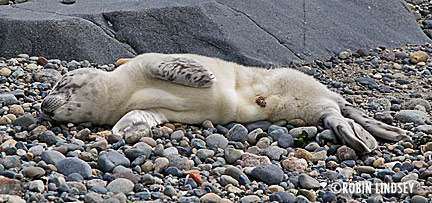 Early Friday morning, Wynken was discovered sleeping in the rocks on the opposite side of the lighthouse and was markedly thinner (photo shown). Photos were reviewed by WDFW’s marine mammal biologist. Based on body weight it was obvious that there was no attending female. Most likely, Wynken had not eaten since he was born 3-5 days earlier.
Early Friday morning, Wynken was discovered sleeping in the rocks on the opposite side of the lighthouse and was markedly thinner (photo shown). Photos were reviewed by WDFW’s marine mammal biologist. Based on body weight it was obvious that there was no attending female. Most likely, Wynken had not eaten since he was born 3-5 days earlier.
The difficult decision was made to remove the pup from the beach for humane euthanasia before he suffered. Lanugo seal pups are not candidates for rehabilitation in the Northwest, based on their health challenges and high mortality in nature. Therefore, if abandoned, euthanasia is the only option. Since Seal Sitters MMSN has a binding contract with NOAA giving us the authority to respond to marine mammals, we are obligated to abide by NOAA policy and guidelines, as are area rehabilitation facilities.
Read here for NOAA policy on lanugo pups.
On Friday afternoon, First Responder Robin drove Wynken to be sedated and then euthanized.
After the ensuing necropsy, we can now say for sure that mom was never present for this pup, since the intestines and stomach were entirely empty. Why the pup was abandoned is purely speculation. 90% of all lanugo pups in the wild are abandoned within a week and die. Pups are born prematurely for a reason (including disease, genital birth defect or high contaminant loads). The seal mom often innately knows the pup, whose lungs and muscles have not fully developed, is not viable to survive. She must then think of her own survival and not waste precious resources. Certainly, there could have been human interference and she was scared off. Or, she could have died giving birth. The answer to this question, we will never know.
What we do know, however, is that volunteers, First Responders and neighbors did their best to give Wynken a chance for mom to return if she was in the area.
Seal Sitters cannot thank our volunteers enough for looking after this very special pup. The work we do can be so difficult at times, since even full-term pups have a 50% mortality their first year. Seal Sitters is committed to giving these beautiful little beings peace on our beaches - so they have their best shot at survival on our watch.
This was a very sad day.
Wynken, Blynken, and Nod one night
Sailed off in a wooden shoe —
Sailed on a river of crystal light,
Into a sea of dew.
First Responder Lynn was on the scene within minutes. Through her binoculars, she could see that the pup was covered almost entirely in fluffy, white lanugo fur, normally shed inside the womb as a pup matures to full-term before birth. A fleshy umbilicus was visible. Lynn’s heart sank. She knew it was going to be a tremendous challenge to keep the beach quiet in hopes mom might return to nurse him.
It was urgent to keep the public - and dogs - as far away as possible and volunteers out of sight as well. Lynn immediately called the volunteer scheduler for the day. Denise checked the online calendar and began ringing volunteers who had entered time for the day. Wearing blue i.d. vests, they were stationed alongside barricades strung with yellow tape, far down the beach south and north of the lighthouse. Waterfront homeowners were alerted that a newborn pup was on the beach and asked to please keep a low profile - they were happy do anything to help. It was truly a life and death situation for the pup.
Neighbors graciously allowed First Responders Lynn and David access through their property so we could periodically get quick health assessment photos, crouched on their deck (Seal Sitters owes them tremendous thanks). Photos revealed that the pup was 80% lanugo (about 2 weeks premature) and, based on the condition of the umbilicus, was possibly a few days old. The pup was nicknamed Wynken, from the beloved 1889 children’s poem, Wynken, Blynken and Nod.
As darkness fell, volunteers left their posts for home, but returned to duty again early Thursday morning. Wynken was still on shore and the low tide would enable public access around the point. First Responders noticed the pup seemed thinner, but would occasionally stretch and stir. Volunteers tried to keep up hope that mom was still in the area. Wynken returned briefly to the water at high tide and then was back on shore. Once again, until almost 10 pm, volunteers patiently stood vigil at far ends of the beach for a pup they had yet to see.

The difficult decision was made to remove the pup from the beach for humane euthanasia before he suffered. Lanugo seal pups are not candidates for rehabilitation in the Northwest, based on their health challenges and high mortality in nature. Therefore, if abandoned, euthanasia is the only option. Since Seal Sitters MMSN has a binding contract with NOAA giving us the authority to respond to marine mammals, we are obligated to abide by NOAA policy and guidelines, as are area rehabilitation facilities.
Read here for NOAA policy on lanugo pups.
On Friday afternoon, First Responder Robin drove Wynken to be sedated and then euthanized.
After the ensuing necropsy, we can now say for sure that mom was never present for this pup, since the intestines and stomach were entirely empty. Why the pup was abandoned is purely speculation. 90% of all lanugo pups in the wild are abandoned within a week and die. Pups are born prematurely for a reason (including disease, genital birth defect or high contaminant loads). The seal mom often innately knows the pup, whose lungs and muscles have not fully developed, is not viable to survive. She must then think of her own survival and not waste precious resources. Certainly, there could have been human interference and she was scared off. Or, she could have died giving birth. The answer to this question, we will never know.
What we do know, however, is that volunteers, First Responders and neighbors did their best to give Wynken a chance for mom to return if she was in the area.
Seal Sitters cannot thank our volunteers enough for looking after this very special pup. The work we do can be so difficult at times, since even full-term pups have a 50% mortality their first year. Seal Sitters is committed to giving these beautiful little beings peace on our beaches - so they have their best shot at survival on our watch.
This was a very sad day.
Wynken, Blynken, and Nod one night
Sailed off in a wooden shoe —
Sailed on a river of crystal light,
Into a sea of dew.
Volunteers kick trash's butt - beach cleanup a resounding success
Jun/14/15 08:21 AM
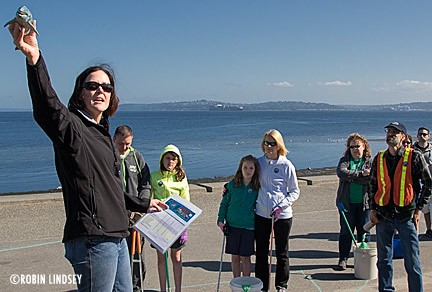
After a short welcoming from Seal Sitters, a heartfelt thank you was extended to PAWS Wildlife volunteers and staff who were in attendance. PAWS is a valued partner of the Marine Mammal Stranding Network as a rehab resource for harbor seal pups. Among the many West Seattle seal pups rehabilitated by PAWS was emaciated Sandy - only to die entangled in derelict fishing line after being returned to health and to the wild. Seal Sitters holds these annual cleanups in honor of Sandy and the Arroyos gray whale.
Peggy Foreman (shown above), education specialist for NOAA Fisheries, spoke about the impact of human trash on gray whales. Grays forage by scooping up large mouthfuls of sediment and water from the sea bottom and sieve small prey and crustaceans (such as tiny ghost shrimp) through their baleen. Sadly, when the ocean floor is littered with human trash, that is sucked in as well. Peggy spoke about the young gray whale who died on the beach in the Arroyos neighborhood in April of 2010. A necropsy of the thin juvenile showed virtually no food in the whale’s stomach, however, a disturbing amount of trash - plastic bags, funnel, golf ball, rope, half a pair of adult sweatpants. Peggy spread out a tarp with a representation of the trash found inside this whale; it provided a striking educational tool used to interact with the public.
Seattle Aquarium Beach Naturalist Daoud Miller pointed out the importance of making sure invertebrates were not using a piece of debris as a home before removing it from the beach. He also reminded participants that moon snail egg casings which look like trash are indeed NOT. Daoud was available throughout the morning, as was Amy Webster of PAWS, to answer questions from volunteers.
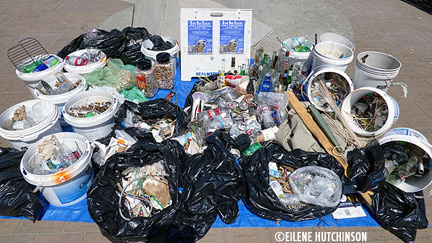
They returned lugging over 9,000 toxic butts and a sizable mass of trash (shown at right), all in less than two hours. People shouted out kudos from their cars as they drove by. Walkers strolling by the Statue Plaza were astonished at the pile that was accumulating and were so thankful for the volunteers’ great work. Some of them signed up on the spot to help out, too. It was amazing how much dangerous trash was collected in such a short time.
Seal Sitters thanks Amy, Daoud and Peggy for making our cleanup so informative. Huge thanks to all of the passionate people who made the beach a much safer home for marine life!
Yesterday afternoon, 42 people attended a Seal Sitters new volunteer training session. All in all, it was a very successful Saturday for wildlife and advocates.
Flipper Fest educates hundreds about marine life
Jun/02/15 09:41 AM
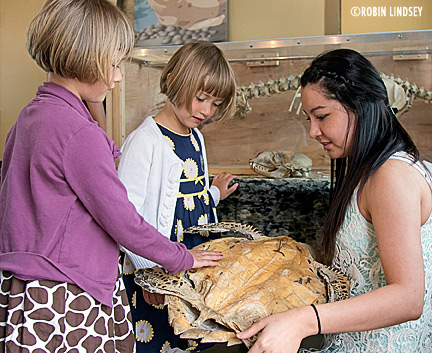
A non-stop steam of kids waited to be “tattooed” with seals, orcas, turtles and even butterfly wings by immensely popular and talented face-painter LaShanna Williams. As they stood patiently in line outside the Bathhouse, there were opportunities to talk with orca experts from NOAA Protected Resources and The Whale Trail about the life-size, inflatable replica of J-pod member, J-26 or “Mike”. Inside the building, the public and volunteers discovered how scientists study killer whale populations. They were challenged to match up photos of orca fins and saddle patches with resident J-pod whales in group photos - just like the researchers do to identify orcas in the wild. As they did so, NOAA educator Peggy Foreman shared facts and life history about each animal.
Exhibitors brought an extraordinary array of artifacts for the public to examine (photo above: WDFW Marine Mammal Investigations intern shows off a sea turtle). Among the many marine biology items on display were fully articulated skeletons of an adult harbor seal and male sea otter, an ear bone from a gray whale (big and heavy), and 8-ft long piece of baleen from a bowhead whale, huge teeth from a sperm whale and flipper bones from a harbor porpoise.
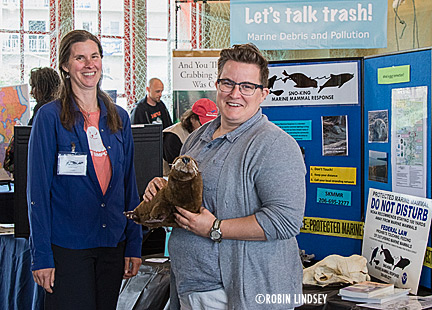
There were lots of opportunities to learn not only about the marine life of Puget Sound and the Pacific Northwest, but also how to protect it from the many dangers of marine debris, derelict fishing gear and pollution. In the “Let’s Talk Trash” corner which was draped in gill nets, crab lines and buoys, Puget Soundkeeper Alliance, Tox-ick, Seal Sitters and Northwest Straits Foundation showed informative videos with interactive displays. Adults and kids alike took the “Escape Cord Challenge” and learned how crab pots work - and about the urgent efforts being made to reduce the number of whale entanglements in crab gear. Experts explained about the trash and toxins that enter our waterways from streets, sidewalks and sewers. By sharing powerful information and adopting simple lifestyle changes, we can all work together to make our marine environment safer for wildlife. Join Seal Sitters’ beach cleanup on Saturday morning, June 13th - details here.
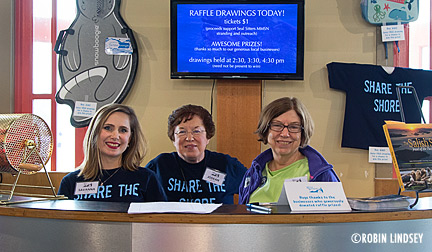
Like clockwork, tables were set up according to pre-planned diagrams, including a kids art area and raffle booth. The in-progress bottle cap artworks (inspired by East Coast artist Denise Hughes) were placed on easels next to hundreds of colorful caps, awaiting children’s imagination. Thanks to Denise who donated a print of “Seal Pup” bottle cap piece, created especially for this event (from a Robin Lindsey photo of seal pup Shanti). It adorned the entrance from Alki Beach. Volunteers directed arriving exhibitors and helped unload vehicles and provide any additional assistance.
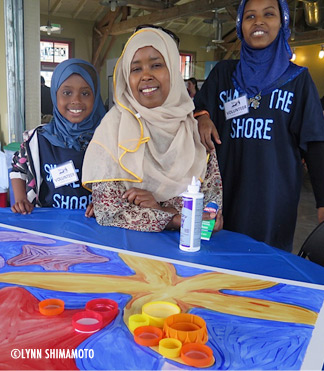
Special thanks to everyone who participated - the Flipper Fest exhibitors who so elevated this event with such amazing displays and expertise, the many area businesses who donated prizes for the raffle drawings and raised funds for Seal Sitters’ stranding and educational activities and the many people who purchased the $1 tickets!
Flipper hugs and humongous thanks to our Seal Sitters volunteers (including Ayan and her daughters Falhado and Sumaiyah who helped out at the kids bottle cap art table). You all continue to amaze us with your environmental stewardship and dedication to protecting marine life!
For related posts listing all participants and contributing businesses, please click here.
(please check back for more photos)
Help wildlife - beach cleanup scheduled for June 13th
Jun/02/15 06:33 AM
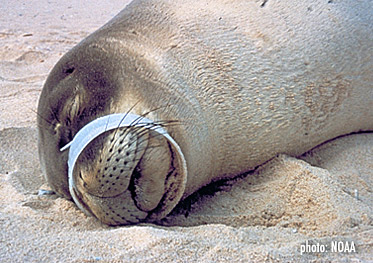
Did you know that an estimated 80% of marine debris originates from land? Or that 360 billion cigarette butts are discarded in the U.S. alone each year - all of them leaching toxic chemicals into the soil and waterways? Did you know that derelict fishing gear and plastics injure and kill many thousands of marine mammals and seabirds annually?
For Seal Sitters, derelict fishing gear is an up close and personal issue. To find out why and for more details about the cleanup, please visit our website. To ensure we have enough materials on hand for volunteers, an RSVP is requested. Seal Sitters is co-sponsoring this event with partners Seattle Parks, PAWS Wildlife Center and the Alki Community Council.







